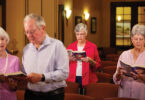
by Olivia Martin
olivia.martin@theleaven.org
TOPEKA — Hundreds.
That’s how many relics Father Tim Haberkorn has collected over the years.
Pastor of Sacred Heart-St. Joseph Parish in Topeka, Father Haberkorn has lent his relics to be displayed at the Strawberry Hill Museum in Kansas City, Kansas, where all are free to venerate them.
But what is a relic? What does it mean to venerate them?
Father Haberkorn explains the basic ins and outs of relics in this week’s CatholicSpeak.
Q. What are relics?
A. Relics are physical remains of a saint (or someone who is considered holy but not yet officially a saint) as well as objects that have been touched to the saint or holy person’s body.
There are three types or “classes” of relics, Father Haberkorn explained.
“First-class relics are the actual teeth or bones or hair of a particular saint,” he said. “Second-class relics . . . would be like a habit they wore or items they used personally. Third-class relics are like a cloth or material that has been touched to a first- or second-class relic.”
Q. Why does the church have relics?
A.“The purpose of them is to foster devotion to the saints because they help lead us to Christ,” said Father Haberkorn. “They remind us of the communion [of saints] that we are [a part of] — the connection we have in the body of Christ.”
Q. Where does the tradition of venerating relics come from?
A. The veneration of relics originated during Christ’s life. The woman in the Gospel of Matthew who was healed by touching Jesus’ cloak as he passed by is an example of this.
The veneration of relics of the saints comes from the early history of the church. Documentation exists from the year 156 that the early Christians venerated the remains of St. Polycarp, an early bishop in Smyrna, which is in present-day Turkey.
Venerating relics became a widespread practice when Christianity was legalized in the Roman Empire in 313.
Q. How do you know something is a relic?
A. First, a relic must come from a credible source.
A cardinal, bishop or other delegated person will conduct a “scrutiny” to authenticate the relic, which can include interviews and research for documentation of its validity.
Once a relic is deemed authentic, the person conducting the scrutiny provides a document of authentication and his seal, which is then attached to the relic.
Also, a relic is housed in a reliquary.
Q. What is a reliquary?
A. A reliquary is a container for relics. Lockets, glass cases and altars are some examples of reliquaries.
Q. What does it mean to venerate a relic? What does it look like?
A. Venerate means to show honor. Venerating relics often involves an exterior display of respect, such as touching or kissing the reliquary, bowing, kneeling, or making the sign of the cross.
Father Haberkorn explained that venerating relics serves as a reminder that the temporal and eternal are linked.
“We need the tangible, we need the concrete,” he said. “That’s why the relics of saints are so important to us — because they help us remember these were actual human beings, flesh and bone just like us.
“They can inspire our humanity to seek . . . heaven.”
Q. How are relics different from mummies on display at a museum?
A. “Every human is the work of God’s hand and needs to be respected and needs to be honored,” said Father Haberkorn. “So, in that sense, there is no distinction.”
The true distinction is the fact that relics come from people who have verifiably lived exemplary lives in terms of faith.
“We distinguish them with a greater honor because they’re kind of like our heroes,” said Father Haberkorn.
Q. Are Catholics required to venerate relics? Is it a sin to be skeptical about them?
A. No, Catholics are not required to venerate relics and it is not a sin to be skeptical about them.
However, venerating relics is an opportunity for deeper devotion to Christ through his saints.
Q. Why do Catholics care so much about relics when they have the Eucharist?
“The relics are not on the same level as the Eucharist because that’s God,” said Father Haberkorn. “But [relics] help ground us in who we are today and what our future holds in Christ.”
Ultimately, the veneration of relics is useful not in developing devotion to a particular saint, but in helping direct the faithful to Christ through the example of another person’s life.






